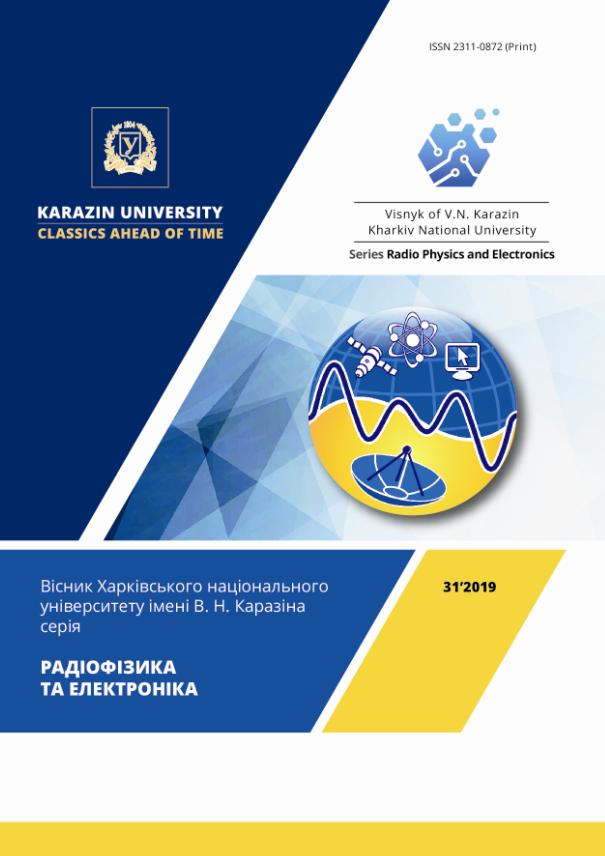Система позиціонування на імпульсних надширокосмугових полях
Анотація
Актуальність. Системи позиціонування на основі радіохвиль широко застосовуються як у глобальному масштабі, так і для точного визначення положення об’єктів у закритих приміщеннях. Глобальні системи позиціонування, як правило, потребують коштовної високоякісної часової синхронізації, допускають суттєві похибки за неналежних погодних умов, при падінні радіохвиль на земну поверхню під малими кутами, затінюванні приймачів великогабаритними перешкодами та за наявності радіоелектронних завад різної природи.
Мета роботи. Пропонується дослідження принципово нової системи позиціонування із використанням надширокосмугових імпульсних електромагнітних полів та їхнього аналізу штучною нейронною мережею.
Матеріали та методи. Для визначення положення приймача надширокосмугових хвиль використовується явище зміни форми імпульсу від кута, під яким він випромінюється антеною. Для початку, розглядається двовимірний випадок цієї задачі. Збуджуючи різними імпульсними сигналами дві антени, що рознесені на відому відстань одна від одної, можна визначити місце розташування приймача за умови знання кутів приходу імпульсів від кожної антени. В якості опромінювачів використовуються надширокосмугові антени типу «метелик», які збуджуються гаусовими імпульсами різної тривалості. Форми прийнятих імпульсів розраховуються методом кінцевих різниць у часовому просторі (FDTD). Класифікація часових форм прийнятих електромагнітних хвиль від різних антен під різними кутами випромінювання здійснюється глибокою нейронною мережею.
Результати. Показано, що штучна нейронна мережа для проведення класифікації особливу увагу приділяє проміжкам часу, де прийнятий імпульс змінюється найшвидше. Чотиришарова мережа безпомилково розрізняє прийняті сигнали від різних антен. Числове моделювання електродинамічної задачі та навчання штучної нейронної мережі показало можливість визначення кутів випромінювання штучною нейронною мережею з точністю до одного градусу за деякими непринциповими винятками. Використовуючи базу між антенами в 50 метрів, досягнута точність визначення положення приймача не гірше 62 см в квадраті 50 на 50 метрів за винятком деяких кутів, для яких точність падає до 2 метрів.
Висновки. Властивість антен змінювати форму випромінених надширокосмугових імпульсів від кута може бути використана для побудови нової системи позиціонування, яка не потребує часової синхронізації із передавачем. Запропонована система може бути ефективно використана у закритих приміщеннях. Відмінною особливістю системи позиціонування на імпульсних електромагнітних хвилях є її висока завадостійкість до існуючих вузькосмугових електромагнітних хвиль.
Завантаження
Посилання
Gangshan W, Chiyuan C, Ning Y, Haifang H, Peifeng X. Design of differential GPS system based on BP neural network error correction for precision agriculture. In Proceedings of 2019 Chinese Intelligent Automation Conference (CIAC–2019); 2019 Sep 20-22; Jiangsu, China. LNEE 586. P . 426-438.
Pochanin GP, Pochanina IE, Kholod PV, Masalov SO. The Experiments on Radiation of Short Pulse Signals by the Large Current Radiators of Dr. H. F. Harmuth. Radio Physics and Radio Astronomy. 2002;7(4):379-384.
Harmuth HF. Nonsinusoidal Waves for Radar and Radio Communication. New York:Academic Press; 1981.
Brena RF, García-Vázquez JP, Galván-Tejada CE, Muñoz-Rodriguez D, Vargas-Rosales C, Fangmeyer J. Evolution of indoor positioning technologies: a survey. Journal of Sensors. 2017;6(359). doi: 10.1155/2017/2630413
Exel R. Receiver Design for Time-Based Ranging with IEEE 802.11b Signals. International Journal of Navigation and Observation. 2012;2012:15.
Dumin O, Prishchenko O, Pochanin G, Plakhtii V, Shyrokorad D. Subsurface Object Identification by Artificial Neural Networks and Impulse Radiolocation. 2018 IEEE Second International Conference on Data Stream Mining & Processing (DSMP-2018); 2018 Aug 21-25; Lviv, Ukraine. p. 434-437.
Persanov I, Dumin O, Plakhtii V, Shyrokorad D. Subsurface object recognition in a soil using UWB irradiation by butterfly antenna. 2019 XXIVth International Seminar/Workshop on Direct and Inverse Problems of Electromagnetic and Acoustic Wave Theory (DIPED); 2019; Lviv, Ukraine. p. 160-163.




